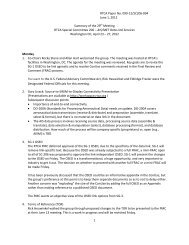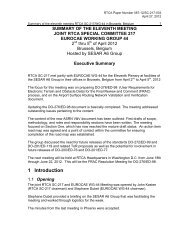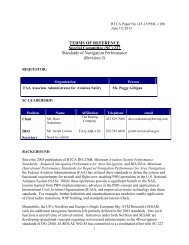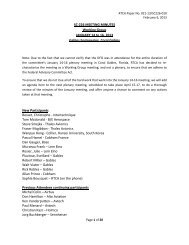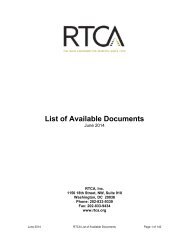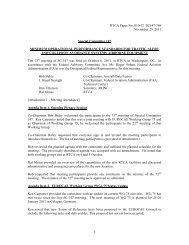RTCA Paper No. 138-12/PMC-1008 June 13, 2012 TERMS OF ...
RTCA Paper No. 138-12/PMC-1008 June 13, 2012 TERMS OF ...
RTCA Paper No. 138-12/PMC-1008 June 13, 2012 TERMS OF ...
Create successful ePaper yourself
Turn your PDF publications into a flip-book with our unique Google optimized e-Paper software.
<strong>RTCA</strong> <strong>Paper</strong> <strong>No</strong>. <strong><strong>13</strong>8</strong>-<strong>12</strong>/<strong>PMC</strong>-<strong>1008</strong><br />
<strong>June</strong> <strong>13</strong>, 20<strong>12</strong><br />
<strong>TERMS</strong> <strong>OF</strong> REFERENCE<br />
Special Committee (SC) 216<br />
Aeronautical Systems Security<br />
(Revision 4)<br />
REQUESTORS:<br />
Boeing Commercial Airplanes<br />
Organization<br />
Person<br />
Munir Orgun,<br />
Electronic Systems Chief<br />
Engineer<br />
SC LEADERSHIP:<br />
Position Name Affiliation Telephone email Change<br />
Co-Chairs Chuck<br />
(425) 342-2906<br />
chuck.royalty@<br />
Royalty<br />
boeing.com<br />
DFO<br />
Secretary<br />
Dan Johnson<br />
Raymond<br />
Decerchio<br />
Derek Schatz<br />
Boeing<br />
Commercial<br />
Aircraft<br />
Honeywell<br />
(763) 954-6548<br />
daniel.p.johnson<br />
@honeywell.com<br />
FAA, AIR-<strong>12</strong>0 (202) 385-6331 raymond.w.<br />
decerchio@<br />
faa.gov<br />
Boeing<br />
Commercial<br />
Aircraft<br />
(425) 760-0644 derek.p.schatz@<br />
boeing.com<br />
BACKGROUND:<br />
Existing aircraft system safety guidance does not specifically address airborne network and data security<br />
issues, which results in non-standardized and potentially inequitable agreements between the various<br />
applicants and the various regulatory agencies on an acceptable process and means of compliance for<br />
ensuring safe, secure and efficient aircraft network design and operations.<br />
This Special Committee is needed to bring together aircraft manufacturers and systems designers,<br />
CNS/ATM systems designers and operators, airlines maintenance and operations personnel and<br />
government (primarily civil aviation authorities) to form a consensus and document guidance for security<br />
of aircraft systems.<br />
1
DELIVERABLES:<br />
Product Description Due Date Change<br />
Security Assurance and<br />
Assessment Methods for<br />
Safety-related Aircraft Systems<br />
(new document DO-XXX)<br />
The document should propose methods<br />
for systems affected by security<br />
considerations to be developed and<br />
assessed.<br />
<strong>June</strong> 20<strong>13</strong> <strong>June</strong> 20<strong>12</strong><br />
Security Assurance and<br />
Assessment Processes for<br />
Safety-related Aircraft Systems<br />
(DO-326)<br />
Security Guidance for<br />
Continuing Airworthiness<br />
(new document DO-YYY)<br />
The document provides guidance for<br />
systems affected by security<br />
considerations to be developed and<br />
assessed.<br />
The document should propose guidance<br />
for continuing airworthiness for systems<br />
affected by security considerations.<br />
Dec 2010<br />
(completed)<br />
<strong>June</strong> 20<strong>13</strong> <strong>June</strong> 20<strong>12</strong><br />
Update to Security Assurance<br />
and Assessment Processes for<br />
Safety-related Aircraft Systems<br />
(revised DO-326)<br />
The document should update guidance<br />
for systems affected by security<br />
considerations to be developed and<br />
assessed to include all category aircraft.<br />
<strong>June</strong> 20<strong>13</strong> <strong>June</strong> 20<strong>12</strong><br />
Additional deliverables will be defined by the Special Committee during development of the above<br />
document, no later than December 20<strong>12</strong>.<br />
SCOPE:<br />
The scope of this committee is the type certification for airworthiness, instructions for continued<br />
airworthiness (ICA), and operational implementation of the ICA, (hereinafter referred to as continuing<br />
airworthiness) of installed aircraft systems connected to an aircraft electronic network. The committee<br />
will address conditions where the security of the system interfaces or information crossing those<br />
interfaces may cause or contribute to a failure condition that impacts aircraft safety of flight - excluding<br />
communication, navigation, and surveillance services managed by US Federal agencies or their<br />
international equivalents.<br />
The material developed by this SC will encompass the following:<br />
a. Security threats can be identified as those that impact aircraft safety and those that have<br />
business or privacy implications, but no impact on safety of flight. This SC will only develop<br />
guidance material that addresses installed aircraft systems when the airworthiness and safety of<br />
flight of those systems has been impacted by information security threats from non-installed<br />
systems.<br />
2
. Aircraft systems and equipment:<br />
i. All aircraft systems electronic equipment.<br />
ii. Electronic networks used for on-board data exchange and for information exchange<br />
with systems external to the airplane, and data exchange with portable devices<br />
(passenger).<br />
c. Assumptions about and considerations for the impact of security on aircraft systems and<br />
equipment from aircraft external systems, including, as necessary, means for the evaluation and<br />
assessment of such systems in terms useful to airborne security processes. The following systems<br />
will be considered, but only the portions that have an effect on aircraft safety:<br />
i. Airline-owned systems<br />
ii. Airport-owned systems<br />
iii. Private network service providers<br />
The SC will not address:<br />
a. Other aspects of safety already addressed in existing guidance material, such as AC/AMJ<br />
25.<strong>13</strong>09, ARP 4754, DO-178B, DO-278, and DO-254, except to the extent where there is a<br />
reliance on those other means of compliance.<br />
b. Physical security or physical attacks on the aircraft (or ground element)<br />
c. Airport, Airline or Air Traffic Service Provider security (e.g., access to airplanes, ground<br />
control facilities, data centers, etc.)<br />
d. Communication, navigation, and surveillance services managed by US Federal agencies or<br />
their international equivalents (for example; GPS, SBAS, GBAS, ATC data communications,<br />
ADS-B, etc.).<br />
ENVISIONED USE <strong>OF</strong> DELIVERABLE(S)<br />
The Security Assurance and Assessment Processes and Methods for Safety-related Aircraft Systems<br />
and the Security Guidance for Continuing Airworthiness documents are intended to be used by the FAA<br />
and other civil aviation authorities (CAAs) as an acceptable means of addressing the security-related<br />
safety aspects of aircraft systems. It is envisioned that the documents would be invoked by an Advisory<br />
Circular for applicable aircraft types for certification. The continuing airworthiness document would be<br />
invoked by an Advisory Circular for operators responsible for operating and maintaining a secure aircraft<br />
system.<br />
SPECIFIC GUIDANCE:<br />
The special committee should develop guidance material that, at a minimum:<br />
a. Provides processes and methods for assessing system networks for security threats and to identify<br />
specific Aeronautical Networked System Security Issues.<br />
b. Identifies network and data security issues that may impact aircraft safety and those where the<br />
impact is more business or privacy related, yet still important.<br />
c. Establishes assurance levels for security that relate to existing safety assurance (e.g., AC/AMJ<br />
25.<strong>13</strong>09) criteria and levels and provides objectives for evaluating network security<br />
implementations<br />
d. Contains acceptable methods of demonstrating system safety when security issues impact aircraft<br />
systems.<br />
e. Addresses recording and responding to security “events” and guidelines for operations, continued<br />
operational safety and maintenance of security features.<br />
f. Addresses the requirements and guidance for post-response recovery, including identification of<br />
affected systems, restoration of system configurations, notification requirements, and other<br />
related activities.<br />
3
g. Will help aircraft manufacturers, system developers, and operators ensure their systems comply<br />
with the guidance material and maintain required levels of safety where security vulnerabilities<br />
have been identified.<br />
h. Identify attributes and characteristics of architectures and designs that constitute good practice, or<br />
which should be considered as basic to aeronautical security implementations.<br />
During preparation of its deliverables, the SC should:<br />
1. Emphasize that security should be considered early in the aircraft and network design and from an<br />
aircraft systems perspective.<br />
2. Recognize the international implications of Aeronautical Network System Security and that aircraft<br />
operate globally.<br />
3. Consider emerging technology and systems.<br />
4. Consider establishing a Security Domain Reference Model as a means to classify the effect of<br />
Aeronautical Network Systems Security Issues.<br />
5. Develop, to the extent possible, an approach (or approaches) that accommodate changes in<br />
technology and that recognizes that aeronautical network system security is an on-going process<br />
(continued operational safety) and more involved than a single point-in-time analysis (operations,<br />
maintenance of security features). The material should focus on security objectives rather than<br />
specific solutions that may become obsolete in the future.<br />
6. Consider the unique role that cryptographic technology plays in typical network security<br />
architectures. Determine what design and operational compliance methods are appropriate and<br />
adequate for the application of this technology to safety-related functions.<br />
7. Recognize that today, the airworthiness of Aeronautical Networked Systems is largely maintained<br />
by Airline processes and procedures approved by regulatory agencies, and that Aeronautical<br />
System Security will likely be maintained in a similar manner by the same people.<br />
ICC Coordination – Complete.<br />
EUROCAE Coordination - <strong>RTCA</strong> SC-216 will coordinate with EUROCAE WG72 to the extent practical.<br />
<br />
Initial Documentation<br />
Documents<br />
FIPS 140-2, “Security Requirements for<br />
Cryptographic Modules”<br />
FIPS 199, “Standards for Security Categorization<br />
of Federal Information and Information Systems”<br />
FIPS 200, “Minimum Security Requirements for<br />
Federal Information and Information Systems”<br />
NIST SP 800-37, “Guide for the Security<br />
Certification and Accreditation of Federal<br />
Information Systems”<br />
NIST SP 800-64, “Security Considerations in the<br />
Information System Development Life Cycle”<br />
NIST SP 800-30, “Risk Management Guide for<br />
Information Technology Systems”<br />
NIST SP 800-23, “Guidelines to Federal<br />
Organizations on Security Assurance and<br />
Acquisition/Use of Tested/Evaluated Products”<br />
NIST SP 800-53, “Recommended Security Controls for<br />
Federal Information Systems”<br />
Intended Use<br />
The Special Committee should examine the<br />
guidance provided by these documents when<br />
developing the committee products.<br />
4
TERMINATION:<br />
Activities of Special Committee 216 will terminate with approval by the <strong>PMC</strong> of the committee’s final<br />
documents listed in the Terms of Reference. Any change/extension of a committee’s work program<br />
requires prior <strong>PMC</strong> approval.<br />
5




